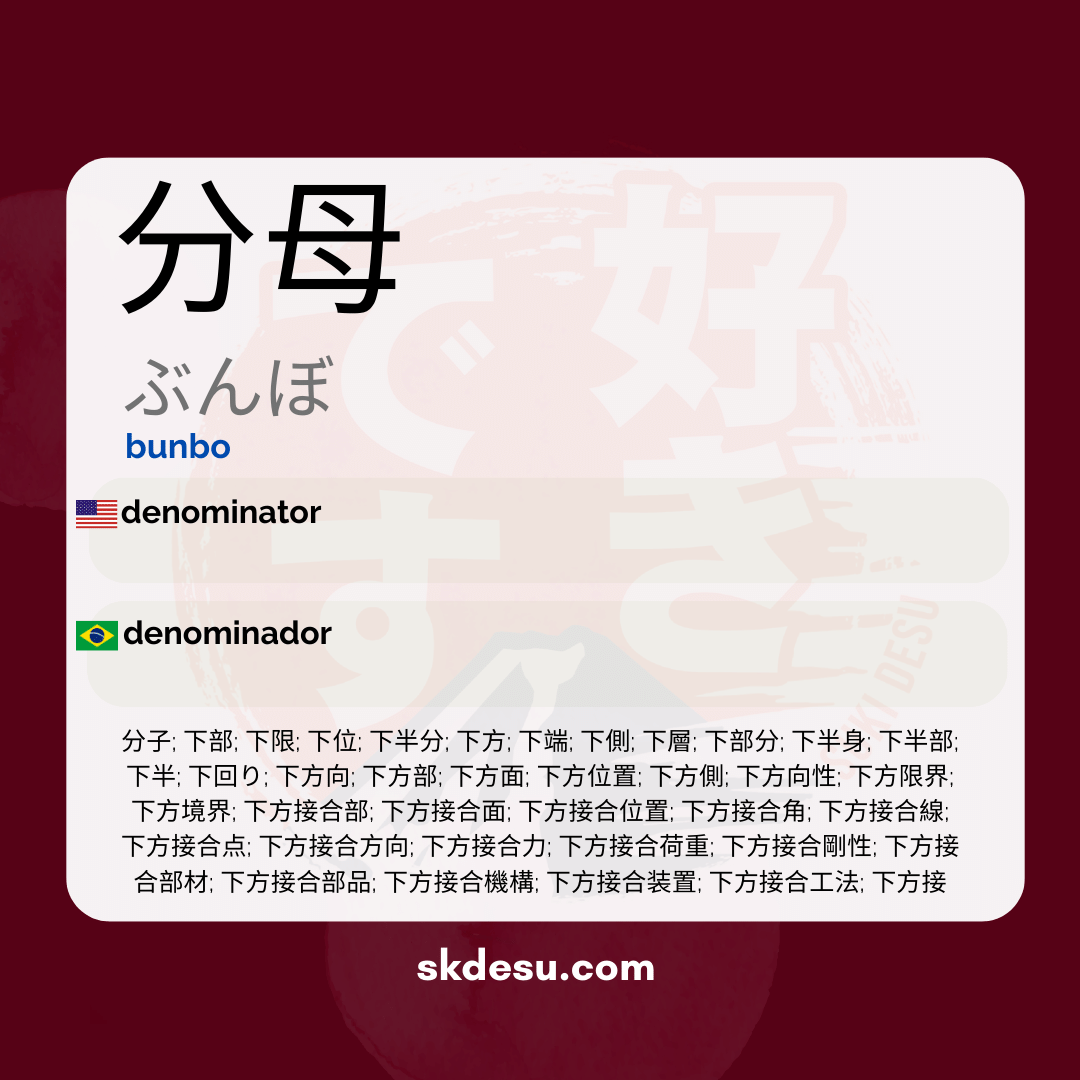Translation and Meaning of: 分母 - bunbo
On this page, we will study the meaning of the Japanese word 分母 (bunbo) and its translation into English. Let's see their different meanings, example phrases, explanations, etymology and the similar words.
Romaji: bunbo
Kana: ぶんぼ
Type: noun
L: jlpt-n1
Translation / Meaning: denominator
Meaning in English: denominator
Definition: In division, a number that represents the number that can be divided.
Sumário
- Etymology
- Vocabulary
- Writing
- Phrases
Explanation and Etymology - (分母) bunbo
分母 (ぶんぼ / bunbo) means "denominator" in Japanese. The etymology comes from the characters used: 分 (ぶん / bun) means "to divide" or "part," and 母 (ぼ / bo) means "mother." Thus, 分母 can be understood as the "part" or “mother” that divides a fraction.
The Japanese word 「分母」 (ぶんぼ) is composed of two kanji: 「分」 and 「母」. The kanji 「分」 has meanings related to division, part, or fraction, and it is one of the most commonly used kanji when we talk about parts or proportions. On the other hand, 「母」 means "mother," but in this context, it is used to denote the main part or base of something. Thus, 「分母」 refers to the denominator in a fraction, which serves as the base or "mother" of the mathematical fraction.
Definition and Use
In mathematics, 「分母」 is used to describe the bottom part of a fraction, representing the total number of equal parts into which something is divided. It is fundamental in fractional calculations and also in complex mathematical expressions, where understanding the denominator is essential for solving equations. Furthermore, knowledge about 「分母」 is crucial for understanding operations such as addition and subtraction of fractions.
Origin and Everyday Application
The origin of the use of 「分母」, like many Japanese mathematical terms, is deeply rooted in the adaptation of Western concepts during the educational modernization period in Japan, which took place from the late 19th century. Mathematics, as a Western discipline, brought along terms that needed to be adapted or created to fit the Japanese language. In everyday life, the word 「分母」 may not be widely used outside of specialized educational or mathematical contexts, but its understanding is fundamental from the early years of study in schools.
It is interesting to note that in mathematics education in Japan, there is a strong focus on visual and conceptual understanding of fractions, which involves a deep understanding of the role of the 「分母」. This reflects the way Japan approaches mathematics education, emphasizing complete understanding of concepts before moving on to more complex topics.
Synonyms and similar words
- 分子 (bunshi) - molecule; a unit composed of two or more atoms
- 下部 (kabu) - bottom; lower section
- 下位 (kai) - lower position; lower level
- 下方 (kahō) - bottom part; direction down
- 下半分 (kahanbun) - lower half; bottom part of something
- 下端 (kadan) - lower extremity; lowest point
- 下層 (kasō) - lower layer; bottom stratum
- 下半身 (kahan-shin) - lower half of the body; area below the waist
- 下方部 (kahō-bu) - bottom; section located at the bottom
- 下方面 (kahōmen) - bottom aspect; bottom surface
Words with the same pronunciation: ぶんぼ bunbo
How to Write in Japanese - (分母) bunbo
See below a step-by-step guide on how to write the word by hand in Japanese (分母) bunbo:
Example Sentences - (分母) bunbo
Below are some example sentences:
Bunbo wa bunshi yori mo ookii desu
The denominator is larger than the molecule.
- 分母 - means "denominator" in Japanese.
- は - is a Japanese grammatical particle that indicates the topic of the sentence.
- 分子 - It means "numerador" in Japanese.
- よりも - It is a Japanese expression that means "more than".
- 大きい - means "big" in Japanese.
- です - is a polite way of saying "is" in Japanese.
Other words of the same type: noun
See other words from our dictionary that are also: noun

